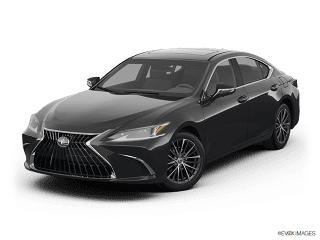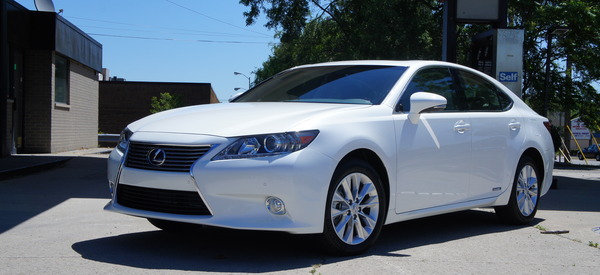
2013 Lexus ES 300h
2013 Lexus ES First Drive Review
We sample the next ES in Southeast Michigan.
Web2Carz Contributing Writer
Published: June 14th, 2012
When it comes to well-known automotive platform pairings, the Toyota Camry/Lexus ES duo has long been one of the best known. So color us surprised when during a press briefing about the redesigned 2013 Lexus ES, company officials said that the car had much more in common with the next Toyota Avalon than it did with the Camry.
Perhaps that's the biggest news here--never mind the updated styling (inside and out), the addition of new features, or the addition of a hybrid model for the first time in the ES' history. Either that, or we've spent too much time in the sun again.
Let's back up a second: the curtain lifted on the sixth-generation ES at the New York Auto Show in April, and Lexus is targeting a mid-August on-sale date. Like the previous five generations, the car remains a mid-size, front-wheel drive sedan, and it's been Lexus' best-selling car over the years. And now, it's all new.
Well, sort of all new. It's wearing new duds, and the cabin is dramatically different, but the V-6 engine in ES 350 models puts out the same output as before. And as we'd soon find out, even an external makeover doesn't necessarily change driving dynamics.
-
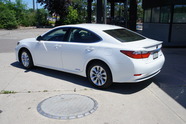
Features & Prices
The ES comes in two flavors: ES 350 (powered by a conventional gas V-6) and ES 300h (as the "h" suggests, it's a hybrid). The car grows somewhat in length compared to before, adding 1.8 inches of wheelbase and one inch of overall length, and it gains some available features that the previous generation didn't offer.
One of those new features is an available heated steering wheel--this marks the first time for the ES. Other available luxury features (depending on package) include: a Mark Levinson uplevel audio system, a navigation system, Lexus' Enform multi-media app suite, heated and ventilated front seats, passenger seat memory, a panoramic sunroof, Lexus' Remote Touch interface, wood interior trim, a rear sunshade, leather seats, a power tilt/telescope steering wheel, keyless entry and starting, Bluetooth, a USB port, an auxiliary port, and a power trunk lid. There's only one trim level, but there are three option packages: Premium, Luxury, and Ultra Luxury. Pricing has not yet been announced. -
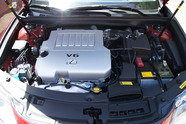
On The Road
We drove the hybrid first before swapping into the V-6, and then we capped our day off with a spin in the previous-generation car for comparison's sake.
Both cars come with a drive-mode selector that features Eco, Normal, and Sport modes. As one would expect, the Normal mode is meant to give the best mix of fuel economy and sportiness in daily driving, while Eco is meant to maximize fuel economy. As the name implies, Sport is then supposed to change both the steering feel and the powertrain setup for a sportier feel (activate Sport mode in the hybrid, and a tachometer suddenly appears in the gauge cluster). In practice, the differences are subtle at best (the hybrid does feel slightly faster in Sport mode, although throttle response seems about the same), and we suspect most buyers will be content to leave the car in normal mode. We did sample the hybrid's EV mode (keeps the car in all-electric mode up to 25 mph if the throttle is applied judiciously) and found that it worked as advertised.
The 3.5-liter V-6 in the 350 is rated at 268 horsepower and 248 lb-ft of torque (just like last year), and it feels pretty punchy around town, even chirping the tires if launched aggressively from a stop light (uh, not that we'd know). The hybrid, which uses a 2.5-liter four-cylinder that matches up to an electric motor (the gas engine makes 156 horsepower and 156 lb-ft of torque, with total system horsepower coming to 200), feels only a tad slower. The hybrid's transition from gas to electric mode isn't always seamless or quiet--all sorts of mechanical whooshing can be heard while coming to a stop, even with the audio turned up.
Otherwise, the car is pretty quiet and buttoned-down, as one expects a Lexus to be. Some wind and tire noise came into the cabin when traversing some of southeast Michigan's worst roads, but otherwise, we found it a quiet place to do business. By comparison, the 2011 car on hand was like a rock concert, with enough wind noise coming in from the driver's side window that we kept checking to make sure the window was rolled up.
Ride and handling are evolutionary steps up from the old model. The car feels tighter and more sorted/less floppy, but then again, the 2011 example on hand had over 9,000 miles on the clock. Steering feel is tighter than the old car, but not by much. It's damning with faint praise to suggest the car has any steering feel at all--it does, but it's exactly the highly-boosted type that one would expect in a car like this. The ride is composed without being soft, but we can't imagine that the ES is much fun on a winding country road. Nor do we expect it to be; Lexus knows its audience and has built a car just for them. -
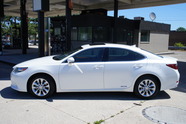
Exterior
The updated look works better in person than in photos. It's still conservative, which is exactly the point--ES buyers aren't generally the flashy type. Lexus does want the buyer demographic to skew younger, and the slightly sportier looks could help, but there's still no mistaking this car for what it is--a premium mid-size sedan catering to a conservative (stylistically, if not necessarily politically) clientele.
ES 350s are set apart from hybrids by their dual exhaust, while ES 300hs get blue badging and an integrated rear spoiler. -
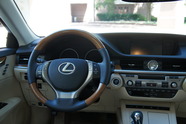
Interior
The cabin is drastically different, and it's a good-looking place in which to hang out. The available wood trim looks and feels good, and soft-touch materials abound. Remote Touch is easy to use, and there's plenty of space for taller folks both up front and in the rear. Luxury touches like an analog clock give the car a bit more personality than it previously had.
-
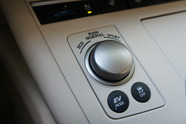
Safety & Fuel Economy
Aside from the 10 airbags (including driver's and passenger's knee) the ES has available safety features like a rearview camera, adaptive cruise control, blind-spot monitoring, rear cross-traffic detection, a parking assist system, and a lane-departure warning system.
Fuel economy is rated at 21 mpg city/31 mpg highway/24 mpg combined on the V-6 and 40/39/39 on the hybrid. -
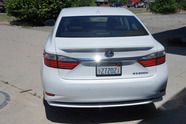
Wrapping Up
When we saw the wraps come off this car at the Javits Center in New York this spring, we weren't surprised to see that the update over the previous car wasn't extremely different. After all, Lexus likely isn't keen on messing with success. We appreciate that the V-6 feels stronger (despite identical power numbers), are impressed by the new cabin, and like that Lexus is finally offering a hybrid in its best-selling car.
The ES will never be a barn-burner. But that matters not to Lexus. What matters is sales numbers, and Lexus would like to get those to 5,000-6,000 ES units per month. The best way to do that is to stay the course.
Besides, enthusiasts who intend on buying a Lexus might like the company's IS rear-drive mid-sizer. Yes, that car is getting long in the tooth, but Lexus is revamping most of its lineup, so we wouldn't be shocked to see a new IS on the roads before too long.
Evolution over revolution appears to be the name of the game with the next ES. And that will probably work just fine for Lexus.
So much for a shake-up at the country club.
• For more information such as specs, prices, and photos of the 2013 Lexus ES 350, click here: 2013 Lexus ES 350.














